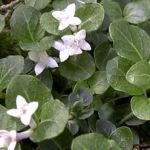| Common Name: |
Running Box |
| Other Names: |
Noon Kie Oo Nah Yeah, Partridge Berry, Running Fox, Squaw Berry, Squaw Vine, Two-Eyed Berry, |
| Botanical Name: |
Mitchella repens |
| Genus: |
Mitchella |
| Family: |
Rubiaceae |
| Native Location: |
N America |
| Cultivation: |
Moist, rich, neutral to acid soil in shade. |
| Propagation: |
By seed sown in autumn; by division in spring. May be invasive. |
| Harvest: |
Plants are cut in summer and dried for infusions, liquid extracts, and tinctures. |
| Height: |
5-30cm (2-12in) |
| Width: |
Indefinite |
| Hardiness: |
Z4-9 |
| Parts Used: |
Whole plant |
| Chemical Constituents: |
Dextrin
Mucilage
Saponins
Wax
|
| Properties: |
A bitter, astringent herb that is diuretic, relaxes the uterus, strengthens uterine contractions, and calms the nerves. |
| Known Effects: |
Helps body dispose of excess fluid by increasing amount of urine produced
Shrinks tissues
Prevents secretion of fluids
|
| Possible Additional Effects: |
May make labor less difficult
May help flow of milk in lactating women
May treat insomnia
May decrease diarrhea
May treat congestive heart failure, kidney failure, liver failure
|
| Medicinal Uses: |
Internally for menstrual disorders, preparation for childbirth, labor pains, and nervous exhaustion, and irritability. Not given during the first six months of pregnancy but may be given alone, or combined with Rubus fruticosa (See, Blackberry) as a uterine tonic during the last two months. |
| Warnings and Precautions: |
Don't take if you:
Are pregnant, think you may be pregnant or plan pregnancy in the near future.
Consult your doctor if you:
Take this herb for any medical problem that doesn't improve in 2 weeks (There may be safer, more effective treatments.)
Take any medicinal drugs or herbs including aspirin, laxatives, cold and cough remedies, antacids, vitamins, minerals, amino acids, supplements, other prescription or non-prescription drugs.
Pregnancy:
Don't use unless prescribed by your doctor.
Breastfeeding:
Don't use unless prescribed by your doctor.
Infants and Children:
Treating infants and children under 2 with any herbal preparation is hazardous.
Others:
None are expected if you are beyond childhood, under 45, not pregnant, basically healthy, take it only for a short time and do not exceed manufacturer's recommended dose.
Storage:
Store in cool, dry area away from direct light, but don't freeze.
Store safely out of reach of children.
Don't store in bathroom medicine cabinet. Heat and moisture may change the action of the herb.
Safe Dosage:
Consult your doctor for the appropriate dose for your condition.
|
| Toxicity: |
Rated relatively safe when taken in appropriate quantities for short periods of time. |
| Bibliography: |
Encyclopedia of herbs by Deni Brown Copyright © 1995, 2001 Dorling Kindersley Limited. pg 279
Vitamins, Herbs, Minerals & Supplements The Complete Guide by H. Winter Griffith, MD Copyright©1998 Fisher Books pp. 403-404 |

